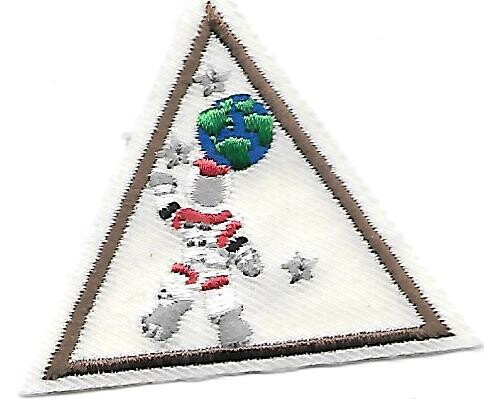Cosmic Adventures Rolling Hills Council own Brownie Try It (Original)
Requirements:
1. Something flying that we cannot classify is a UFO, an Unidentified Flying Object. You have probably heard of them in movies as alien spacecraft, but really they can be anything airborne that you can’t recognize. Everything initially started out as being a UFO, until scientists gave it a name for example, a comet. Make your own UFO and then have a friend say what this UFO is. Remember it can’t be a name already used to describe something.
2. Everything floats in space so, when eating, astronauts have to be extra careful. Pretend to eat like an astronaut by drinking from closed containers ex: a juice box, and eating food out of a tube.
3. When flying into space every piece of weight counts. Astronauts are only allowed to bring a few small light personal items, for example a flute or CD player. What would you bring on your space trip if you could only bring 10 items? Why?
4. There are many requirements to be an astronaut. One of the most important is to be and stay physically fit. Astronauts typically exercise 1 ½ to 2 hrs every day. They ride a bicycle, walk on a treadmill and exercise the upper body with a spring-pulley system. Try to do some of these exercises for a few minutes, running instead of bicycling, and using a resistance rubber band to stretch your arms.
5. There are many things out in space, ranging from stars, moons, comets, to people, space stations, and satellites. What do you think of when you hear the word ‘space’? Make a picture cube drawing six different ideas.
6. Space is different because of its lack of gravity. Scientists do experiments in space to see what will happen. One scientist wanted to know what happened to fire. They did an experiment, and the flames formed little balls of fire floating around. Figure out an experiment that you would want to be done in space? What do you think would happen? Tell a friend about your experiment and see what she thinks will happen.
7. In order to be in space you must get there. Think of how you would get to space, then watch a real space launch. Consider how you will sleep, read a book, and go to the bathroom. Have fun and find out the real answers too.
8. The lack of gravity in space is a unique feeling. Using a partner, do an experiment to experience weightlessness. Then using a partner, see how gravity affects water by doing the next experiment.
Experiment 1: Anti-gravity
1) With a partner have one person be the spacewomen and the other the gravity simulator. 2) Have the spacewomen stand straight with her arms straight, down at her sides. 3) The gravity simulator should hold down the spacewomen’s arms. 4) The spacewomen should try to push her arms upward, but only pushing as hard as the gravity simulator can hold them down. Do this for 15 seconds. 5) Now the gravity simulator should let go. Talk about how this felt and what you think it will feel like in space.
Experiment 2: How do drops of water move? You will need: Raincoat or plastic apron or bathing suit, water, paper towels, and a friend
1) Put on the water protection gear. Wash your face standing at the sink. In what direction does the drops of water go? 2) Lie down on the floor. Have your friend help you wash your face. In what direction does the drops of water go? 3) Lie on your side. Have your friend help you wash your face. In what direction do the drops of water fall? What made the water go in the same direction every time? How do you think water drops would move in a spacecraft? Why? (Leaders, they become round water droplets that go everywhere.)
9. The spacesuit of an astronaut is special, but it is also big and hard to move around in. See how astronauts feel by putting on a pair of special big and bulky gloves. Then go around and try to do things with your hands, for example turn on a lamp.
10. An astronaut needs to know where they are going. So, they must know about outer space and our solar system. Name the planets in our solar system and draw a picture of your favorite one. Then find a fun fact about your favorite planet.
